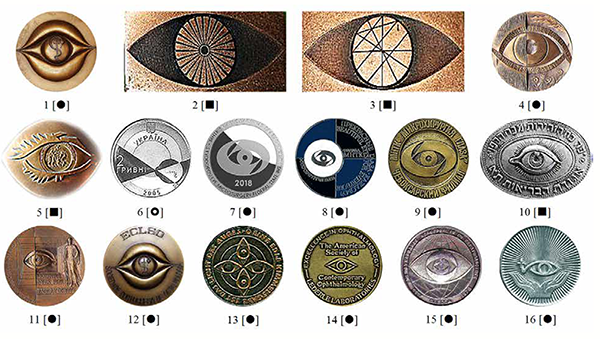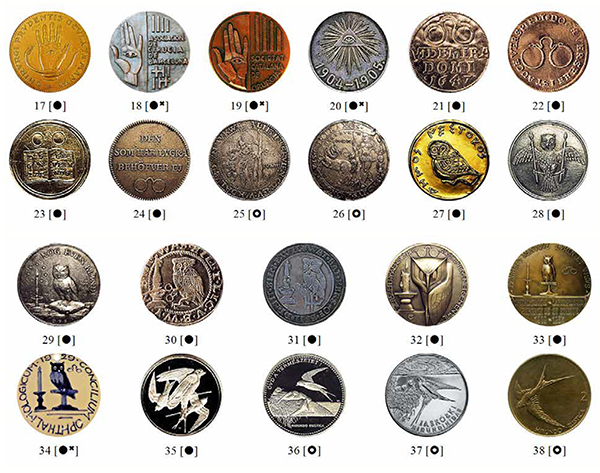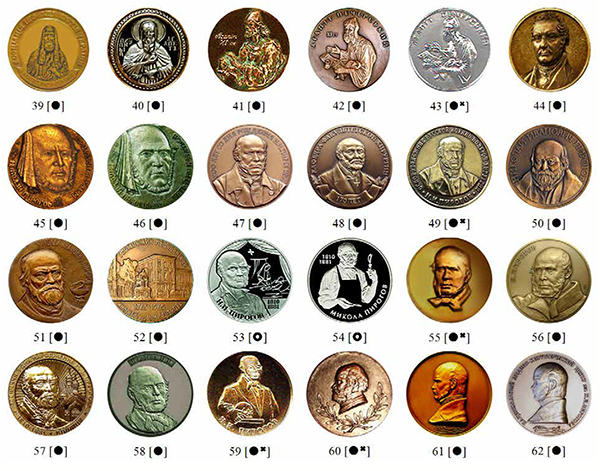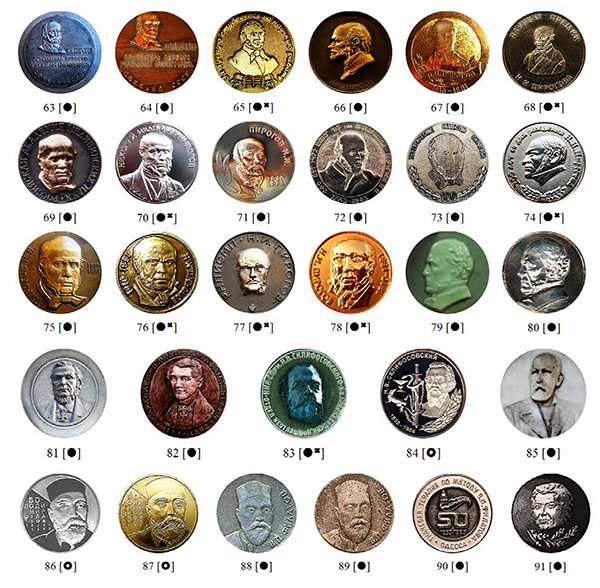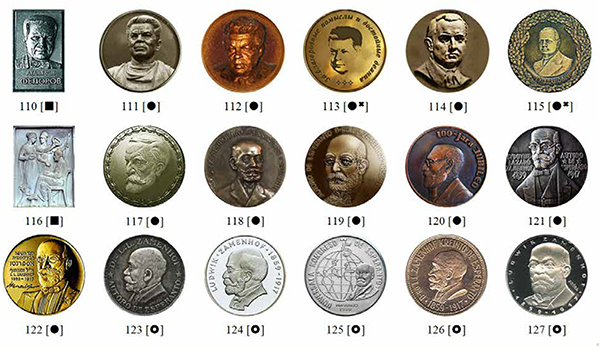J.ophthalmol.(Ukraine).2021;1:72-79.
|
http://doi.org/10.31288/oftalmolzh202127279 Received: 07 September 2020; Published on-line: 19 April 2021 Symbols of ophthalmology and famous Ukrainian oculists in the mirror of numismatics O. V. Syniachenko, V. M. Iermolaeva, K. V. Liventsova, S. M. Verzilov, V. V. Gerasimenko Donetsk National Medical University; Lyman (Ukraine) E-mail: synyachenko@ukr.net TO CITE THIS ARTICLE: Syniachenko O. V., Iermolaeva V. M., Liventsova K. V., Verzilov S. M., Gerasimenko V. V. Symbols of ophthalmology and famous Ukrainian oculists in the mirror of numismatics. J.ophthalmol.(Ukraine).2021;2:72-79. http://doi.org/10.31288/oftalmolzh202127279 Ophthalmology has a long history which is represented on numismatic materials. The branch of historical science numismatics (from the Latin "numisma" – coin) originated in the 19th century and became closely related to economics, politics, culture and law, and includes the thematic study of coins, medals and plaques. The history of ophthalmology is best illustrated by various forms of medal art (exonum or paranumism), and the medal became the prototype of a commemorative (memorial) coin. In this work, the authors presented a catalog of 127 numismatic materials (105 medals, 6 plaques, and 16 coins), including some unique ones, presented for the first time. Numismatic materials depicting common international symbols of this science ("eye", including "eye on the palm", "owl", "pince-nez", "candle") were reflected and the stages of development of native ophthalmology presented. The paper includes also references to significant historical events in ophthalmology and a highlight of biographies of 16 scientists who contributed invaluably to the formation of this science and whose lives were associated with Ukraine. The medals show the portraits of the ancient Kyiv doctor Agapetus and the founders of modern world ophthalmology. Unfortunately, up to date, eminent oculists of the past have been not sufficiently commemorated by issues of numismatic pieces. Hence, it is our hope that in the future, a systematic approach to this matter as well as the purposeful promotion of the achievements of national ophthalmology by numismatics will be used, to provide a clear example for studying the history of ophthalmology and enhance the educational attainment of doctors. Keywords: medicine, ophthalmology, history, numismatics
Introduction Ophthalmology has a long history of development [1]. It has been reported that there were ancient Greek physicians during the epoch of antiquity, and later, Byzantine and Arabo-Islamic physicians, specializing in “diseases of the eye and lids” [2]. It is noteworthy that physicians tried to treat for strabismus in the 5th century BC [3], and those of the ancient Rome had some knowledge on the manifestations of other eye diseases (like pterygium, entropion and tumors). We owe to Celsus the description of the couching of the cataract. Such ancient Rome physicians like Antyllus, a famous surgeon who also performed the couching of the cataract, and Rufus of Ephesus, an author of a great description of the anatomy of the eye, are still remembered [4]. Avicenna and Rhazes, the famous physicians of Persian civilization, were well-known oculists of their time [5]. However, it was as late as the 19th century that clinical experimental studies demonstrated the association of visual function with the state of the central nervous system [6], and as late as the mid-20th century that studies on histology, cytochemistry, biochemistry and immunology of the ocular tissue became common [7]. Numismatics contributes to our understanding of the history of medicine. The word originates from the Latin numisma (coin) which means “an established custom, public order, tradition, rule of law”. In this regard, the “coin” (a flat disc or piece of metal with an official stamp, used as money; unit of cost) turned into a derivative of “full measure, legal norm”. Dating back to the 19th century, numismatics is a branch of historical science associated with economics, politics, culture and law [8]. The numismatic stock includes coins, medals and plaquettes (from French “small plaque”, “a small low relief sculpture in bronze or other materials”) which represent also the persons, symbols and events related to ophthalmology [9, 10]. There are the commemorative (memorial) and award medals portraying not only oculists, but also physics, physiologists and opticians who contributed much into the development of ophthalmology, and the issues marking ophthalmological congresses [11, 12] and national ophthalmological associations and societies [13]. The history of ophthalmology is best reflected by various forms of medallic art (exonumia or paranumismatics). The medal was a precursor of memorial coin. At present, the field of medical numismatics includes over 20 thousand of coins and memorial medals [14]. The first medically-oriented coins feature the image of god Asclepius with his snake-entwined staff, or caduceus [15]. The invention of a metal coin with certifying images and inscriptions was made in two neighboring communities of Aegeides, the kingdom of Lydia situated at the Western coast of Asia Minor (685 BC) and the Aegean island in Greece (between the Peloponnesus and Attica). It should be emphasized that the images of medicine featured as far back as the ancient coins of Greece and Rome [16]. The aim of this study was to evaluate the generally recognized symbols of and the development of international ophthalmology, and the roles of the famous Ukrainian oculists reflected on the numismatic stock. For the first time, we have analyzed 127 coins, medals and plaquettes collected into a certain catalogue with a short review of historical events; the thorough collection and description process taking many years. In this paper, certain special features are indicated by the following conventional signs: [°], a coin; [●], a medal; [●х], a medal with a pendant; and [■], a plaquette. Results Symbols of ophthalmology in the mirror of numismatics The eye [17] (Figs. 1-6) for long has been a traditional symbol of ophthalmology, and can be seen on medals and plaquettes issued by special patient care institutions (Figs. 7-11) and marking the ophthalmology congresses and conferences held in Portugal (Fig. 12), Germany (Fig. 13), the USA (Fig. 14), and Ukraine (Fig. 15). On the Ukrainian medal, a symbolic affected eye is carefully supported by ophthalmologist’s palms (Fig. 16). Ophthalmological associations from the Netherlands and Spain have as their emblem the silhouette of an eye on the doctor’s palm (Figs. 17-19). Myths of various peoples across the globe have been for long associated with a magic power of a deity to see while being invisible. There were popular beliefs that a person could live only until his vision failed (“a live eye”). The stealing eyes from (or the blinding of) a deity with subsequent treating this deity for blindness is a common mythological motif, and this treating was perceived as a way of rebirth. The deity’s eyes themselves were a mythical object, and were often washed with water, simulating tears. According to ancient Egyptian mythology, the god Horus lost his eye in a struggle with Seth, but later regained it, which enabled the revival of his father, Osiris. Since that time, the iconic Eye of Horus (also called Wadjet) (Fig. 20) has become a symbol of not only ophthalmology, but medicine in general. Pince-nez is another old symbol of ophthalmology and can be seen on numismatic material issued in the 15th century and later (Figs. 21-24). Sometimes the pince-nez (spectacles) is used to symbolize optics. Although emerald was used as the first proxy vision correction lens, it should be noted that it has been very rarely used as a symbol of optics, and no relevant numismatic stock is available. Brillenthaler is known to be the first coin bearing the image of spectacles. This nickname was given to a variety of Thaler issued by Duke Julius of Brunswick-Lüneburg at Goslar and Wolfenbüttel from 1586 to 1589, and comes from what appears to be spectacles (brillen) below the skull and hourglass in the wild man's hand (Figs. 25-26). An owl is known to have good night vision, and its image became a later symbol of ophthalmology. The medal struck on the occasion of the Panhellenic Ophthalmology Congress depicts this bird (Fig. 27). More seldom an owl can be seen with spectacles (a German medal, Fig. 28). Spectacles are sometimes depicted on or with an owl and a lit candle (Figs. 29-34); the candle was believed to allow persons with poor vision to see clearer. It is noteworthy that medieval medicine drawings depict a lit candle for daylight setting. This indicated on the use of the candle to symbolize the profession of a doctor, which was first proposed by the French surgeon Ambroise Paré (1516-1590). The emblem of William Harvey, the English physician (1578-1657) who made influential contributions in physiology and embryology, shows a white sleeved arm holding a lit candle against a red background. In addition, the candle was used on the portraits of the two anatomists and physicists, Jan Jessen (Johannes Jessenius, 1566-1617), the Czech graduate of the Padova University and Rector of Charles University, and Nikolaus van Tulp (1593-1674) from the Netherlands, together with their legendary personal mottos, “Officio mi officio” and "Aliis inserviendo consumor", respectively. A swallow sometimes symbolizes pediatric ophthalmology (Figs. 35-38) because it was believed that this bird collected poppy juice to restore vision in the children who had been born blind. According to ancient Greek myths, swallows restored sight to their blind nestlings with use of celandine. By the way, the Greek word for the plant is “Chelidon”, meaning a swallow. Famous oculists, Ukraine and numismatics Agapetus of the Kyiv Caves (? - 1095) (Figs. 35-38), an Orthodox Christian saint and a monk in Kyiv Pechersk Lavra, is believed to be the first Ukrainian physician. He treated Prince Volodymyr Monomakh successfully, and was rather popular among all segments of the population of ancient Kyiv as a healer for eye disease, for which he used ointments, fats and herbal-and-root potions. Iefrem Iosypovych Mukhin (1766-1850) (Fig. 44), M.I. Pyrogov’s teacher, the initiator of the anatomical and physiologic field in medicine, and the founder of a theory of the key role of the brain in the functioning of the visual system, was also a founder of the science of eye trauma. He was born in the Ukrainian village of Zarozhne, studied at the Kharkiv Spiritual Collegium and Ielisavetgrad Medical-and Surgical School (now Mukhin Kropivnytskyi Medical College), and became a doctor of medicine and surgery, honorary Professor at Moscow University and Moscow Medical and Surgical Academy. Mykola Ivanovych Pyrogov (1810-1881) (Figs. 45-80), a world-famous surgeon, prominent anatomist and teacher, author of the first atlas of topographical anatomy, and pioneer of battlefield surgery, was born in Moscow. He graduated from the medical schools of the universities of Moscow and Dorpat (now Tartu in Estonia), worked at his alma mater and Petersburg Medical Surgical Academy (while simultaneously heading the Hospital Surgery Clinic), had advanced training in inflammatory diseases of the cornea and lids and investigated surgical intervention methods for cataract and pupil formation in Germany, and provided reports of 88 cases of eye diseases, including 13 that involved cataract surgery (reclination). M.I. Pyrogov was chief surgeon of Sevastopol at the time of the Krimean war in 1855, when the town was besieged by the British, French and Turkish forces. He was the trustee of the Kyiv educational district since 1858 to 1861, and, thereafter, retired to his estate Vyshnia at the outskirts of Vinnytsia, where he built a hospital and pharmacy. A disciple of M.I. Pyrogov, Professor and Actual Privy Councilor Volodymyr Opanasovych Karavaiev (1811-1892) (Figs. 81-82), was the first eye surgeon in the country. He established a Chair for Diseases of the Eye at the St Volodymyr University of Kyiv in 1844, and subsequently, was the organizer and Dean of the Medical School at the university. In addition, V.O. Karavaiev, the first doctor in Ukraine to use ether anesthesia during surgery, was dealing with plastic surgery and elected an Honorary Citizen of Kyiv. Born at the town of Dubossary, Tyraspol district, Kherson province, Mykola Vasyliovych Sklifosovskyi (actual surname, Sklifos) (1836-1904) (Figs. 83-84) attended the gymnasium in Odessa, graduated from the medical school at the University of Moscow, and worked at the Odessa city hospital, before he became a famous surgeon, professor of the medical school at St Volodymyr Kyiv University, and introduced antiseptic and aseptic methods of treatment into native ophthalmological practice. In addition, he performed surgeries for eye disorders in Poltava, and subsequently worked in St Petersburg and Moscow. Volodymyr Dmytrovych Zalozetskyi (1842-1898) (Fig. 85), a surgeon and famous public figure, was born at the village of Kniazhe, Sniatyn District, Ivano-Frankivsk Region of Ukraine, attended the gymnasium in Chernivtsi, and graduated from the Military Medical Academy of Vienna and the Operative institute of Vienna. He started working at Chernivtsi in 1869, and became the first ophthalmologist in Bukovyna. Volodymyr Petrovych Filatov (1875-1956) (Fig. 86-89), a famous ocular scientist, and, undoubtedly, the founder of native ophthalmology as a science, was born in the village of Mykhailivka, Saransk District, Penza province, attended the classical gymnasium at Symbirsk, and graduated from the medical school at the University of Moscow, where he held his first hospital appointments. He settled in Odesa and started working at the Novorossiisk University in 1903. In 1936, he founded the Ukrainian Institute of Experimental Ophthalmology and was appointed its director. This institute is now known as the Filatov Institute of Eye Diseases. V.P. Filatov developed a method of electric tonometry of the eye in 1913, and subsequently, the tube flap method used in plastic surgery and non-specific tissue therapy (Fig. 90). In addition, he was awarded a title of a Hero of Socialist Labor and elected a full member of the Academy of Science of Ukraine (1939) and the Academy of Medical Science of the USSR (1944). A commemorative medal was issued to honor V.P. Filatov, “one of the fathers of corneal transplant” [18]. Nadiia Oleksandrivna Puchkovska (1908-2001) (Fig. 91), an outstanding ophthalmologist, member of the Academies of Science of the USSR (1971) and Ukraine (1992), Hero of Socialist Labor and Honorary Citizen of the city of Odesa, was a disciple of V.P. Filatov. Born in Smolensk, she graduated from and worked at the Kyiv Medical Institute, and also headed the Eye Department of a special combat evacuation hospital during World War II. She worked at the Filatov Ukrainian Experimental Institute of Eye Diseases (now known as the Filatov Institute of Eye Diseases) since 1946, headed it from 1957 to 1985, and was famous for developing subtotal and corneal transplant and keratoprosthesis techniques and surgical treatment for keratoconus and establishing the first center for treating eye burns. Leonard Leopoldovych Hirshman (1839-1921) (Figs. 92-95), a famous ophthalmologist, was born in Tukums, Kurland province (now Latvia), and after graduating from the medical school at the University of Kharkiv in 1860, he traveled to France and Germany to complete his studies at local clinics. He returned to his alma mater to teach, and in 1875 was promoted to full professor of the first ophthalmological department established at the university. He was elected an Honorary Citizen of Kharkiv. Prof. Hirshman founded the first eye clinic at the university in 1870, personally financed a clinic and a school for the blind, initiated the establishment of the Kharkiv Branch of the Guardianship for the Blind, and contributed to the development of spectacle optics in the city. Mykhailo Iosypovych Averbakh (1872-1944) (Fig. 96) was born in Mariupol, Katerynoslav province, became the founder and the first director of the Helmholtz Institute of Eye Diseases in 1935, and member of the Academy of Science of the USSR in 1939. Nadiia (Nekhama) Isaakivna Pilman (1897-1984) (Fig. 97), a prominent pediatric ophthalmologist, was born in Kurgan, Tobolsk province, studied at the “Higher Courses for Women” in Kyiv and Guerrier Courses (a University for women) in Moscow , and graduated from the medical school at the University of Samara in 1917. From 1947 to 1953, she was involved in the visual rehabilitation of World War II veterans, and, thereafter, in the treatment of childhood blindness and strabismus. Particularly, Dr Pilman founded the eye department at the Children’s Hospital in Kyiv (and headed it until 1967), Kyiv boarding school for visually impaired children (1950) and summer camps for children with strabismus (1973). Valentyn Feliksovych Voĭno-Iasenetskyĭ (archibishop Luka) (1877-1961) (Fig. 98-109) was famous for performing more than a thousand eye surgeries a year and developing primary methods of treatment for suppurative disease of the orbit. He was born in Kerch, Tavria province, attended the gymnasium and art school in Kyiv, and, after graduating from the medical school at the St Volodymyr University of Kyiv in 1903, worked at the Kyiv Red Cross Hospital, became a distinguished specialist in suppurative surgery and anesthesiology, and was awarded the degrees of Doctor of Science (Medicine) and Doctor of Theology. As a noticeable religious figure, he was subjected to political repressions, spent 11 years in internal exile, and was rehabilitated as late as 2000. He was canonized by the Ukrainian Orthodox Church in 1995. Sviatoslav Mykolaiovych Fedorov (1927-2000) (Fig. 110-113) was born in Proskurov (now Khmelnytskyi), Ukraine, spent his childhood years in Kamianets-Podilskyi, graduated from the Medical Institute of Rostov, and, while working at the Chuvash Branch of the Helmholtz Institute of Eye Diseases in Cheboksary, became the first to perform intraocular lens implantation in the USSR. He became head of the Research laboratory of experimental and clinical eye surgery in 1974 and the Moscow Research Institute for Eye Microsurgery in 1980, and founded the Eye Microsurgery Complex, an inter-branch scientific and technical establishment (Figs. 7-9) in 1986. There were famous foreign ophthalmologists who, at some point of their live, were associated with Ukraine. Thus, born in Minsk, Ivan Ustynovych Zdanovych (1864-1915) (Figs. 114-115), a Belarusian philanthropist and public figure, after graduating from the medical school at the St Volodymyr University of Kyiv, had advanced training in ophthalmology in Kyiv. He was appointed as a physician to the village of Loshnytsa, Borysiv district, in 1890, and worked as a chief physician at the Minsk Provincial Zemstvo Hospital since 1904. The Polish physician Jan (Johann) Mikulicz-Radecki (1850-1905) (Fig. 116-117) was born at the Ukrainian town of Chernivtsi. He received his education at the medical school at the University of Vienna and simultaneously at the conservatory of Vienna with a specialty in piano, was a director of surgery at the Jagiellonian University of Krakow, the University of Konigsberg (1887-1890), and the University of Breslau (1890-1905) and an inventor of ocular surgical instruments, and described bilateral swelling of salivary and lacrimal glands, called Mikulicz's syndrome. Dr Ludwik (Lejzer) Zamenhof (1859-1917) (Figs. 118-127), the creator of the artificial language of Esperanto, was born in Bilostok, graduated from the medical school at the University of Warsaw, received advanced training in ophthalmology in Vienna, and practiced ophthalmology in the Ukrainian town of Kherson from 1889 to 1990. In conclusion, it is noteworthy that the main objective of historians of medicine is to commemorate outstanding medical personalities. History of ophthalmology is an essential part of studying ophthalmology. As was noted by R.L. Stevenson (1850-1894), the Scottish writer, “the memories are a fairy gift which cannot be worn out in using”, and, in the words of Oscar Wilde (1854-1900), the English writer, “the only duty we have to history is to rewrite it”. Unfortunately, up to date, eminent oculists of the past have been not sufficiently commemorated by issues of numismatic pieces. Hence, it is our hope that in the future, a systematic approach to this matter as well as the purposeful promotion of the achievements of national ophthalmology by numismatics will be used, to provide a clear example for studying the history of ophthalmology and enhance the educational attainment of doctors. We look forward to the appearance of new interesting materials of such small forms of fine art.
References 1.Sarkisov AS, Sarkisov SA. [The origins of Moscow ophthalmological society]. Vestn Oftalmol. 2018;134(6):129-132. Russian. 2.Laios K, Karamanou M, Chatziioannou A, Nikolopoulos T, Moschos MM, Androutsos G. Views on ocular cancer in Arabo-Islamic medicine and the leading influence of the ancient Greek medicine. J BUON. Jan-Feb 2016;21(1):276-8. 3.Tsoucalas G, Papaioannou T, Karamanou M. Michael Constantine Psellus (1020-1105 AD) and his definition of strabismus. Strabismus. 2018 Sep;26(3):155-157. 4.Bieganowski L. State of ophthalmology in ancient Rome. Klin Oczna. 2004. 2004;106(1-2):126-33. 5.Tabatabaei SM, Sabetkish N, Tabatabaei SM. Ophthalmology in Persian medicine. J Med Ethics Hist Med. 2014 Dec 3;7:19. 6.Tamas LT, Mudry A. Endre Hőgyes (1847-1906), forgotten father of the vestibulo-ocular reflex. Otol Neurotol. 2019 Oct;40(9):e938-e943. 7.Grzybowski A, Kanclerz P. Tadeusz Krwawicz, MD: The inventor of cryosurgery in ophthalmology. Eur J Ophthalmol. 2019 May;29(3):348-356. 8.Kunzmann R. The Saint Eligius, his life and work and his traces in numismatics. Schweiz Arch Tierheilkd. 2014 Jan;156(1):13-6. 9.Magil'nitskiĭ SG. [Ophthalmology in numismatics]. Vestn Oftalmol. 1968 Nov-Dec;81(6):87-8. Russian. 10.Galst JM. Ophthalmological numismatics. Arch Ophthalmol. 2001 Nov;119(11):1709. 11.Györffy I. Ophthalmological medals and coins. Klin Monbl Augenheilkd. 1975 Jan;166(1):114-25. German. 12.Salacz G, Vértes L. [Award medals in Hungarian ophthalmology]. Orv Hetil. 2008 Nov 2;149(44):2097-9. Hungarian. 13.Jaeger W. Numismatic history of the von Graefe Medal of the German Ophthalmological Society. Klin Oczna. Apr-May 1988;90(4-5):186-7. 14.Pearn J. Enduring biographic heritage – medical numismatics. J Med Biogr. 2019 May;27(2):108-115. 15.Mayer R. [The history of a medal (part 2)]. Rev Med Brux. Nov-Dec 2011;32(6):553-9. French. 16.Popkin RJ. Medicine in numismatics. Surg Gynecol Obstet. 1961 Nov;113:657-60. 17.Etienne D. [The eye as a symbol]. Soins. 2010 Apr;(744):41-2. French. 18.Benitez-Herreros J, Lopez-Guajardo L. Vladimir Petrovich Filatov, one of the fathers of corneal transplant. Arch Soc Esp Oftalmol. 2016 Jul;91(7):e67-8.
|

